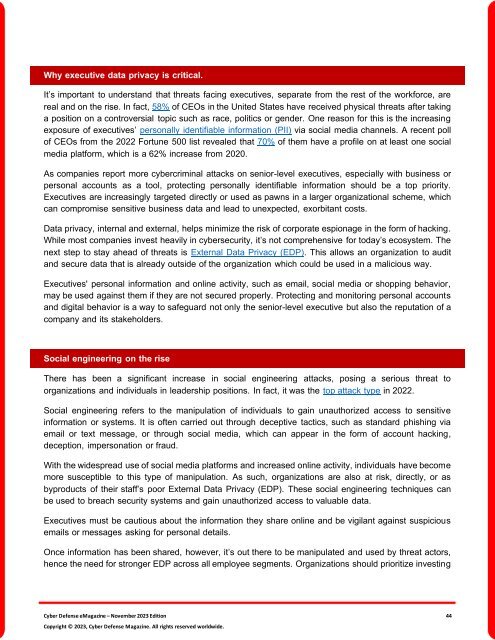The Cyber Defense eMagazine November Edition for 2023
Cyber Defense eMagazine November Edition for 2023 #CDM #CYBERDEFENSEMAG @CyberDefenseMag by @Miliefsky a world-renowned cyber security expert and the Publisher of Cyber Defense Magazine as part of the Cyber Defense Media Group as well as Yan Ross, Editor-in-Chief and many more writers, partners and supporters who make this an awesome publication! 196 page November Edition fully packed with some of our best content. Thank you all and to our readers! OSINT ROCKS! #CDM #CDMG #OSINT #CYBERSECURITY #INFOSEC #BEST #PRACTICES #TIPS #TECHNIQUES
Cyber Defense eMagazine November Edition for 2023 #CDM #CYBERDEFENSEMAG @CyberDefenseMag by @Miliefsky a world-renowned cyber security expert and the Publisher of Cyber Defense Magazine as part of the Cyber Defense Media Group as well as Yan Ross, Editor-in-Chief and many more writers, partners and supporters who make this an awesome publication! 196 page November Edition fully packed with some of our best content. Thank you all and to our readers! OSINT ROCKS! #CDM #CDMG #OSINT #CYBERSECURITY #INFOSEC #BEST #PRACTICES #TIPS #TECHNIQUES
You also want an ePaper? Increase the reach of your titles
YUMPU automatically turns print PDFs into web optimized ePapers that Google loves.
Why executive data privacy is critical.<br />
It’s important to understand that threats facing executives, separate from the rest of the work<strong>for</strong>ce, are<br />
real and on the rise. In fact, 58% of CEOs in the United States have received physical threats after taking<br />
a position on a controversial topic such as race, politics or gender. One reason <strong>for</strong> this is the increasing<br />
exposure of executives’ personally identifiable in<strong>for</strong>mation (PII) via social media channels. A recent poll<br />
of CEOs from the 2022 Fortune 500 list revealed that 70% of them have a profile on at least one social<br />
media plat<strong>for</strong>m, which is a 62% increase from 2020.<br />
As companies report more cybercriminal attacks on senior-level executives, especially with business or<br />
personal accounts as a tool, protecting personally identifiable in<strong>for</strong>mation should be a top priority.<br />
Executives are increasingly targeted directly or used as pawns in a larger organizational scheme, which<br />
can compromise sensitive business data and lead to unexpected, exorbitant costs.<br />
Data privacy, internal and external, helps minimize the risk of corporate espionage in the <strong>for</strong>m of hacking.<br />
While most companies invest heavily in cybersecurity, it’s not comprehensive <strong>for</strong> today’s ecosystem. <strong>The</strong><br />
next step to stay ahead of threats is External Data Privacy (EDP). This allows an organization to audit<br />
and secure data that is already outside of the organization which could be used in a malicious way.<br />
Executives' personal in<strong>for</strong>mation and online activity, such as email, social media or shopping behavior,<br />
may be used against them if they are not secured properly. Protecting and monitoring personal accounts<br />
and digital behavior is a way to safeguard not only the senior-level executive but also the reputation of a<br />
company and its stakeholders.<br />
Social engineering on the rise<br />
<strong>The</strong>re has been a significant increase in social engineering attacks, posing a serious threat to<br />
organizations and individuals in leadership positions. In fact, it was the top attack type in 2022.<br />
Social engineering refers to the manipulation of individuals to gain unauthorized access to sensitive<br />
in<strong>for</strong>mation or systems. It is often carried out through deceptive tactics, such as standard phishing via<br />
email or text message, or through social media, which can appear in the <strong>for</strong>m of account hacking,<br />
deception, impersonation or fraud.<br />
With the widespread use of social media plat<strong>for</strong>ms and increased online activity, individuals have become<br />
more susceptible to this type of manipulation. As such, organizations are also at risk, directly, or as<br />
byproducts of their staff’s poor External Data Privacy (EDP). <strong>The</strong>se social engineering techniques can<br />
be used to breach security systems and gain unauthorized access to valuable data.<br />
Executives must be cautious about the in<strong>for</strong>mation they share online and be vigilant against suspicious<br />
emails or messages asking <strong>for</strong> personal details.<br />
Once in<strong>for</strong>mation has been shared, however, it’s out there to be manipulated and used by threat actors,<br />
hence the need <strong>for</strong> stronger EDP across all employee segments. Organizations should prioritize investing<br />
<strong>Cyber</strong> <strong>Defense</strong> <strong>eMagazine</strong> – <strong>November</strong> <strong>2023</strong> <strong>Edition</strong> 44<br />
Copyright © <strong>2023</strong>, <strong>Cyber</strong> <strong>Defense</strong> Magazine. All rights reserved worldwide.

















